
Ranunculus is a large genus of about 1750 species of flowering plants in the family Ranunculaceae. Members of the genus are known as buttercups, spearworts and water crowfoots.
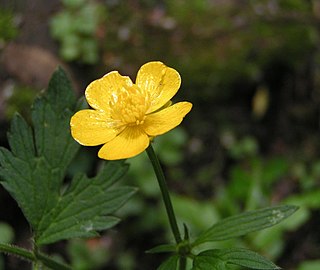
Ranunculus repens, the creeping buttercup, is a flowering plant in the buttercup family Ranunculaceae, native to Europe, Asia and northwestern Africa. It is also called creeping crowfoot and sitfast.

Eriogonum lobbii is a species of wild buckwheat known by the common name Lobb's buckwheat or prostrate buckwheat. It is native to most of the mountain ranges of northern California and their extensions into Oregon and Nevada. It is found in a number of mountain plant communities. The plant is named after William Lobb (1809–1864), the English plant collector.

Geranium bicknellii is a species of geranium known by the common names Bicknell's cranesbill and northern cranesbill. It is native to much of the northern half of North America, where it can be found in a number of forest and woodland habitats. This is an annual or biennial herb which grows hairy stems up to about half a meter long. It may be erect or lie near the ground. Each leaf is several centimeters long and wide and is divided into several lobes, each of which may have smaller lobes or teeth. Flowers grow singly or in pairs and have pointed sepals and small lavender petals, each with a notch in the tip. The fruit has a rounded body with a long, straight style about 2 centimeters in length and tipped with a small beak.

Eriodictyon lobbii is a species of flowering plant in the borage family known by the common names Lobb's fiddleleaf and matted yerba santa. It is native to the Sierra Nevada and southern Cascade Range chain in California and adjacent sections of Nevada and Oregon. It grows in high mountain habitat in dry areas on slopes and ridges.

Ranunculus andersonii is a species of buttercup known by the common name Anderson's buttercup. It is native to the western United States, including the Great Basin and surrounding regions, where it grows in sagebrush, woodlands, and other habitat. It is a perennial herb producing a basal rosette of thick leaves which are each divided into three double-lobed leaflets at the end of a petiole. The inflorescence arises from the rosette on an erect, leafless stalk usually no more than 20 centimeters tall. It bears one flower with usually five white or red-tinged petals each up to 2 centimeters long with white or pinkish sepals at the base. At the center of the flower are many yellow stamens and pistils. The fruit is an achene, borne in a spherical cluster of 14 or more. It was named after Charles Lewis Anderson by Asa Gray.
Ranunculus canus is a species of buttercup known by the common name Sacramento Valley buttercup. It is endemic to California, where it grows in the Central Valley and adjacent mountain foothills, and the Transverse Ranges just south. It grows in grassland and meadows in woodland and forest habitat. This plant can be very similar in appearance to the California buttercup, and may be difficult to distinguish from it. It is variable in form. In general the plant is a perennial herb producing erect, usually hairy stems up to 65 centimeters tall. The hairy leaves are each made up of three leaflets, leaves occurring lower on the plant with wider leaflets which may be notched to lobed, and upper leaves with narrow, toothed leaflets. The flower has up to 23 shiny yellow petals and many yellow stamens and pistils at the center. The fruit is an achene, borne in a spherical cluster of 11 or more.
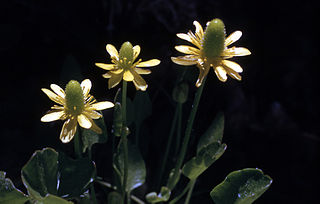
Halerpestes cymbalaria is a species of buttercup known by the common names alkali buttercup and seaside buttercup. It is native to much of Eurasia and parts of North and South America, where it grows in many types of habitat, especially in moist to wet areas such as marshes, bogs, and moist spring meadows. It is a perennial herb producing several stems a few centimeters to nearly 40 centimeters long. Some are prostrate against the ground and are stolons which root in moist substrate, and some are erect. The leaves are variable in shape, the basal ones with notched or slightly divided leaf blades borne on long petioles, and any upper leaves much reduced in size. The inflorescence bears one or more flowers on erect stalks. The flower has five to eight pale yellow petals, each under a centimeter long. The protruding receptacle at the center of the flower becomes a cylindrical cluster of fruits, each of which is an achene.

Ranunculus eschscholtzii is a species of buttercup flower known by the common name Eschscholtz's buttercup.

Ranunculus flabellaris is a species of flowering plant in the buttercup genus, Ranunculus, known by the common name yellow water buttercup or the yellow water crowfoot. It is native to much of North America, including the southern half of Canada and most of the United States.
Ranunculus gormanii is a species of buttercup known by the common name Gorman's buttercup. It is native to Oregon and northern California, where it grows in the Klamath Mountains and a section of the southern Cascade Range. It can be found in moist areas in mountain forests and meadows. It is a perennial herb producing prostrate stems which extend along the ground up to 20 centimeters in length, sometimes rooting at nodes that come in contact with wet substrate. The leaves have oval blades up to 4 centimeters wide which are borne on petioles up to 7 centimeters in length. Flowers have 5 to 7 shiny yellow petals each a few millimeters long and many stamens and pistils. The fruit is an achene borne in a spherical cluster of up to 15.

Ranunculus hebecarpus is a species of buttercup known by the common name delicate buttercup. It is native to western North America, including several of the western United States and Baja California, where it grows in grassland, woodland, and chaparral habitat. It is an annual herb producing a slender, hairy stem a few centimeters high or up to 30 centimeters tall. The hairy leaves are borne on long petioles. Their blades are deeply lobed or divided into three leaflets, often with toothed or lobed edges. Flowers have 3 to 5 tiny yellow petals just 1 or 2 millimeters long studded on the bulbous nectary; some flowers lack petals. The plant is most easily identified in its fruiting stage, when the infructescence is a spherical cluster of several tiny disc-shaped achenes with compressed, bristly sides.
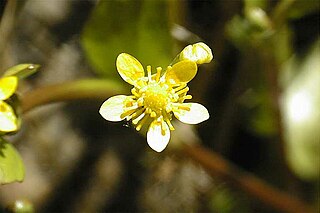
Ranunculus hydrocharoides is a species of buttercup known by the common names frogbit buttercup, or frog's-bit buttercup. It is native to western North America, including the southwestern United States and Mexico. It is also known from Guatemala. It is aquatic or semi-aquatic, growing floating in water or in wet land near water. Typical habitat includes marshes, streams, and lakes. Stems are up to 25 centimeters long, prostrate on the ground when terrestrial, or floating when aquatic. The shiny green leaves have heart-shaped or oval blades up to 3 centimeters long which are borne on petioles which may be 15 centimeters in length. Flowers have 5 to 8 shiny yellow petals a few millimeters long with many stamens and pistils at the center. The fruit is an achene borne in a spherical cluster of 9 or more.

Ranunculus macounii is a species of buttercup known by the common name Macoun's buttercup. It is native to much of North America, from Alaska and northwestern Canada to Newfoundland and Labrador, and the contiguous United States except for the northeast and southeastern areas. It grows in many types of moist habitat, including marshes and wet areas woodlands and scrub. It is generally semi-aquatic, growing in or next to shallow water, or in muddy places. It is a perennial herb producing prostrate, spreading stems that root at nodes that come in contact with moist substrate, or growing erect and branching. The stems are generally hairy, but populations of hairless specimens are known. The leaves are mostly divided into three lobed, toothed leaflets which are borne on long, hairy petioles. The flowers each have five shiny yellow petals under a centimeter long around a center of many stamens and pistils. The fruit is an achene borne in a spherical cluster of 20 or more.

Ranunculus parviflorus is a species of buttercup known by the common name smallflower buttercup. It is native to Europe, but it is known on other areas of the world as an introduced species and sometimes a roadside weed, for example, in parts of Australia and the United States.

Ranunculus sardous is a species of buttercup known by the common name hairy buttercup. It is native to Europe and it can be found in many other areas of the world, including parts of the United States and Australia, as an introduced species and a roadside and lawn weed. It grows in many types of disturbed habitat, especially in moist areas. It is an annual or biennial herb producing a mostly erect, hairy stem up to half a meter tall. The hairy leaves are usually divided into three leaflets which are borne on petioles a few centimeters in length. The flower has usually five yellow petals each up to a centimeter long and five reflexed sepals. The fruit is an achene borne in a spherical cluster of up to 35.
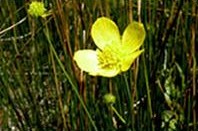
Ranunculus aestivalis is a rare species of buttercup known by the common names fall buttercup and autumn buttercup. It is endemic to the state of Utah in the United States, where it exists only in Garfield County next to the Sevier River. It is restricted to a moist microhabitat in an otherwise dry, open ecosystem, and the amount of available habitat is very limited. This is a federally listed endangered species of the United States. It has been described as "the most graceful and showy members of the genus in the western United States," but also "one of the state's rarest and most restricted plants."
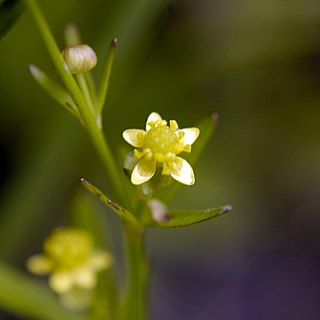
Ranunculus abortivus is a species of flowering plant in the buttercup family, Ranunculaceae. Its common names include littleleaf buttercup, small-flower crowfoot, small-flowered buttercup, and kidneyleaf buttercup. It is widespread across much of North America, found in all ten Canadian provinces as well as Yukon and the Northwest Territories, and most of the United States, except Hawaii, Oregon, California, and parts of the Southwest.
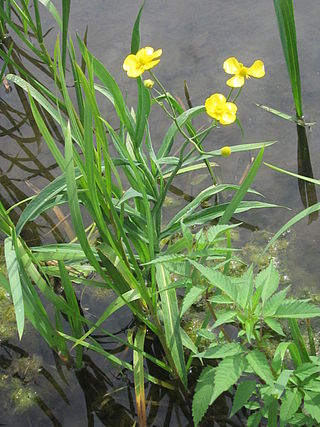
Ranunculus lingua, the greater spearwort, great spearwort, tongue-leaved crowfoot, or water buttercup, is a plant species in the family Ranunculaceae native to temperate areas of Europe, Siberia and through to the western Himalayas. It is a semiaquatic plant that prefers to grow in about 40 cm (16 in) of water in a variety of wetland habitats. A cultivar called 'Grandiflorus', the large-flowered greater spearwort, has 6 cm flowers and is favored by gardeners.
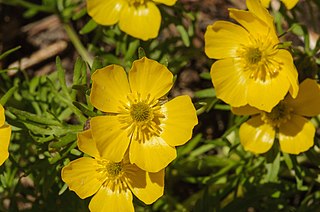
Ranunculus adoneus, the alpine buttercup or snow buttercup, is a species of flowering plant. It is an alpine buttercup from the family Ranunculaceae. This species is mainly found in the Rocky Mountains in Colorado and Wyoming but can also be found in Idaho, northern Utah and eastern Nevada. Its typical habitat is short grass meadows near the edge of melting snow.


















